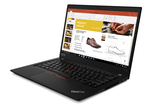Lenovo ThinkPad T14s-20UJS00K00
Ausstattung / Datenblatt

Primary Camera: 0.9 MPix
Preisvergleich
Durchschnitt von 4 Bewertungen (aus 9 Tests)
Testberichte für das Lenovo ThinkPad T14s-20UJS00K00
Das ThinkPad T14s mit dem AMD-Renoir-Prozessor bietet deutlich mehr Leistung und ist zudem günstiger als das Intel-Pendant. Doch wie sieht es mit dem Stromverbrauch und den Akkulaufzeiten aus? Wir sehen uns die Unterschiede im Detail an.
Quelle: It Pro
 EN→DE Archive.org version
EN→DE Archive.org versionPerformance from this chip is phenomenal under sustained load, but in day-to-day use the target audience is unlikely to notice the difference compared to the latest Core i7-powered Dell XPS 13. And if you’re willing to switch allegiance from Windows, the M1 MacBook Pro (and even the cheaper Air) are faster still in optimised programs whilst being even sleeker. We also question this laptop’s value for money: a 256GB SSD at this price is positively stingy, and while the warranty lasts three years, it’s return-to-base rather than on-site. This leaves the ThinkPad T14s in the uncomfortable middle ground, unable to lift itself away from the new MacBooks and its corporate rivals.
Einzeltest, online verfügbar, Lang, Datum: 26.03.2021
Bewertung: Gesamt: 80%
Quelle: Laptop Media
 EN→DE Archive.org version
EN→DE Archive.org versionConsidering the price of the laptop, and the performance it offers, it is probably one of the best business laptops for high-workload scenarios. Not only does it offer supreme power, but it also has quite a lot of goodies in terms of security. You get a dedicated TPM chip onboard, the AMD Memory Guard technology, dual biometric authentication (thanks to the IR face recognition, and the fingerprint reader, both of which work extremely well).
Einzeltest, online verfügbar, Sehr Lang, Datum: 05.11.2020
Quelle: Laptop Media
 Archive.org version
Archive.org versionSupport, online verfügbar, Kurz, Datum: 05.11.2020
Quelle: On MSFT
 EN→DE Archive.org version
EN→DE Archive.org versionLenovo’s ThinkPad T-lineup is a great thin business laptop and with the addition of AMD’s Ryzen PRO chipsets, businesses looking to skimp a few pennies are now being served options that are almost $500 less expensive than its Dell competitor.
Einzeltest, online verfügbar, Mittel, Datum: 28.09.2020
Quelle: PC Mag
 EN→DE Archive.org version
EN→DE Archive.org versionThe ThinkPad T14s flirts with a four-and-a-half-star rating and an Editors' Choice nod, missing those marks mainly due to Lenovo's wrongheaded decision to deny AMD customers a 4K screen option (and the fact that we like to see a Thunderbolt 3 port in an over-$1,000 notebook). But if you're content with a 1080p display, the T14s is a sensational business laptop—lighter, faster, and $493 cheaper as tested than the Dell Latitude 7410 (though that comparison is a bit flawed, since the Dell has a gorgeous 4K display), and a genuine, more affordable alternative to the super-stellar ThinkPad X1 Carbon. Its Ryzen 7 Pro CPU is a monster, delivering near-mobile-workstation levels of raw multithreaded performance, and its engineering is faultless.
Einzeltest, online verfügbar, Lang, Datum: 11.09.2020
Bewertung: Gesamt: 80%
Quelle: Mobile Tech Review
 Archive.org version
Archive.org versionThe 2.8 lb / 1.27 kg ThinkPad T14s is the more affordable counterpart to the ThinkPad X1 Carbon. It has a 12.95mm matte black magnesium alloy shell, the usual excellent ThinkPad keyboard and is available with a variety of displays. You can get it with AMD Ryzen 5 Pro (6-core) and Ryzen 7 Pro (8-core) CPUs for a significant performance boost, or with Intel 10th gen Comet Lake 4-core CPUs for Thunderbolt 3 support. The laptop has ample ports, optional 4G LTE WWAN, a fingerprint scanner, Windows Hello IR camera and strong battery life.
Einzeltest, online verfügbar, Lang, Datum: 05.09.2020
Quelle: Neowin
 EN→DE Archive.org version
EN→DE Archive.org versionIf only it came with a UHD display. Seriously, I get that there are some advantages to choosing Intel, and others to choosing AMD. In terms of what the platform offers, I think there are more advantages from AMD, although you do get Thunderbolt from Intel. What I don't care for is OEMs creating their own value propositions for Intel by only offering certain configurations with an Intel processor. It's not cool.
Einzeltest, online verfügbar, Sehr Lang, Datum: 30.08.2020
Bewertung: Gesamt: 85%
Quelle: Lon.TV
 Archive.org version
Archive.org versionLenovo's new T14s laptop is available in both AMD and Intel varieties. The AMD offers substantial performance advantages over the Intel version.
Einzeltest, online verfügbar, Sehr Lang, Datum: 15.08.2020
Quelle: Neowin
 Archive.org version
Archive.org versionHands-On, online verfügbar, Sehr Lang, Datum: 01.08.2020
Kommentar
AMD Vega 7: Integrierte Grafikkarte in the Ryzen APUs basierend auf der Vega Architektur mit 7 CUs (= 448 Shader) und einer Taktrate von bis zu 1600 MHz.
Diese Klasse ist noch durchaus fähig neueste Spiele flüssig darzustellen, nur nicht mehr mit allen Details und in hohen Auflösungen. Besonders anspruchsvolle Spiele laufen nur in minimalen Detailstufen, wodurch die grafische Qualität oft deutlich leidet. Diese Klasse ist nur noch für Gelegenheitsspieler empfehlenswert. Der Stromverbrauch von modernen Grafikkarten in dieser Klasse ist dafür geringer und erlaubt auch bessere Akkulaufzeiten.
» Weitere Informationen gibt es in unserem Notebook-Grafikkartenvergleich und der Benchmarkliste.
R7 PRO 4750U: Mobile APU mit acht Zen 2 (mit SMT/Hyperthreading) basierten Kernen welche mit 1,7 bis 4,1 GHz takten. Integriert eine Vega Grafikkarte mit 7 CUs und bis zu 1600 MHz Taktfrequenz. Die PRO-Variante bietet zusätzliche Sicherheits- und Managementfunktionen.» Weitere Infos gibt es in unserem Prozessorvergleich Vergleich mobiler Prozessoren und der Prozessoren Benchmarkliste .

